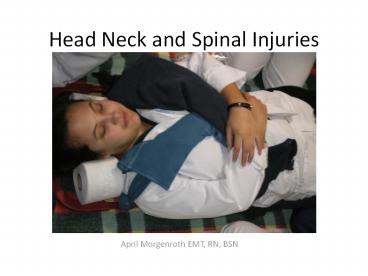Head Neck and Spinal Injuries PowerPoint PPT Presentation
Title: Head Neck and Spinal Injuries
1
Head Neck and Spinal Injuries
- April Morgenroth EMT, RN, BSN
2
Skull
Cervical Vertebrae (7)
mandible
Thoracic Vertebrae (12)
Lumbar Vertebrae (5)
Sacrum
Coccyx
http//www.illustratorsonline.com/cousins/spinal.g
if
3
Central Nervous System
Brain
Spinal Cord
Controls basic essential body functions.
4
The Autonomic Nervous System
The autonomic nervous system controls the bodys
involuntary functions digestion, heartbeat,
respirations
Sympathetic Nervous System Parasympathetic Nervous System
Fight or Flight Regulate the bodys response to danger or threat Vasoconstriction Rapid Heartbeat Deep Respirations Dilated Pupils Rest and Digest The bodys resting state allowing metabolism and energy conservation Vasodilation Increased blood flow to the gut Slower Heartbeat Lower Blood Pressure
lildarlinzkidzdolls.homestead.com/
5
Anatomy of the Skull
Sutures Cartilaginous joints which allow very
little movement.
Cranium
Ocular Orbits
Zygomatic
Maxilla
Mandible
http//www.daviddarling.info/images/skull.jpg
6
Facial Trauma
Facial trauma may cause airway compromise .
Decreased level of consciousness affects patients
ability to protect the airway
Assume that a patient with facial trauma may also
have other head or spinal injuries.
http//www.mothersagainstdogchaining.org/Assets/di
llions-injury-face.jpg
Injury to the central nervous system can affect
the bodys drive to breath.
7
Management of Facial Trauma
Establish and/or maintain the airway
Patient positioning, airway placement,
www.medicswithoutborders.org/images/Opening2
Have suction available to clear airway of
blood
vomit
secretions
Look for and remove
Loose teeth
Foreign Objects
Provide breathing support if needed
Bag valve mask
Provide supplemental oxygen as indicated
Monitor Vital signs and level of consciousness
8
Head Injuries
Open vs. Closed Head Injury
Open and closed refer to the cranial bones and
not the skin.
Open Head Injury A head injury that involves a
fracture to the cranium is an open head injury
Closed Head Injury Any head injury where the
cranium remains intact is a closed head injury.
9
Basic Cranial Anatomy
Skull
Dura Mater
Arachnoid Layer
Pia Mater
10
Traumatic Brain Injury
Concussion
May have brief loss of consciousness
Caused by force that is transferred through the
skull to the brain.
Short term memory loss.
Nausea and vomiting
Headache
The symptoms are only temporary and there is no
actual detectable damage to the brain.
11
Traumatic Brain Injury
Contusion (Brain Bruise)
A blow to the head causes the brain to hit the
skull. In some cases the brain may actually
bounce back injuring the back of the brain too.
http//www.mdusd.k12.ca.us/adulted/ontrack/brain.h
tm
Blood vessels on or in the brain are broken.
Symptoms are similar to those of a
concussion. Bleeding from a contusion may
accumulate to form a hematoma.
http//www.pathology.vcu.edu/WirSelfInst/neuro_med
Students/image/2561traumpix/21contgross.jpg
12
Traumatic Brain Injury
Hematoma
Hematoma a collection of blood around tissue
Epidural Hematoma blood lies between the skull
and the dura
Subdural Hematoma blood lies just below the dura
Intracerebral Hematoma Blood collects inside the
brain tissue
www.neurosurgery.ufl.edu/Images/320hematoma.jpg
13
Monroe Kelly Hypothesis
Closed Box Theory
Tissue
Cerebral Spinal Fluid
Blood
http//www.hypertension-experts.com/Hypertension-b
g.jpg
Increased Pressure
14
Increased Intracranial Pressure
Pressure builds up in the cranium
Systemic blood pressure increases to allow
perfusion to the head.
Brain becomes hypoxic
Carbon dioxide builds up and increases brain
swelling
Respiratory Depression
15
Emergency Care of Traumatic Brain Injury
Determine level of consciousness
Airway Establish or maintain airway
Breathing May need to support breathing with
oxygen and/or manual ventilations
Look for signs of circulation obtain vital signs
Raise the head of a patient with traumatic brain
injury to reduce intracranial pressure
Obtain IV access
Assume that any patient with a traumatic head
injury also has a spinal injury.
16
Emergency Care of Traumatic Brain Injury
In some cases the physician may be able to make a
burr hole into the skull to allow for drainage of
pooled fluids in the brain.
http//content.answers.com/main/content/wp/en/thum
b/f/f1/250px-Plate_20_6_20_extract_300px.jpeg
The patient with traumatic brain injury and
increased intracranial pressure will need to be
transferred to a referral center for advanced
care.
17
Spinal Injuries
www.spineuniverse.com/.../2563/fracture-BB.gif
Fractures
www2.kumc.edu/neurosurgery/Spine2.jpg
Dislocations
http//www.chiro.org/chimages/diagrams/diskslip.jp
g
Disc Injuries
18
Spinal Injuries
Evaluate the patient for possible spinal injury
Substantial force to the upper body.
Think Mechanism
It is possible to have injury to the spinal
column without having injury to the spinal cord.
19
Head and Spine Injuries
Assessment
Nausea/Vomiting
Pupils dilated, pinpoint, unequal
Point Tenderness in the neck or spine
Loss of bladder of bowel control
Altered Level of consciousness
Breathing may be shallow and slow, rapid, or
absent
Paralysis and/or altered sensation
20
Head and Spine Injuries
Ominous Signs
Posturing
http//upload.wikimedia.org/wikipedia/en/thumb/2/2
a/Decorticate.PNG/450px-Decorticate.PNG
Decorticate flexed extremities, drawn in to
toward the core. (increased ICP)
http//www.who.int/malaria/docs/images/hbsm_fig6.j
pg
Decerebrate Extension of the extremities
outward. (Cerebral hypoxia, brainstem injury or
herniation)
21
Neurogenic Shock
Damage to the brain and spinal cord
Loss of Sympathetic Tone
Parasympathetic Nervous System is Unopposed
Uncontrolled Vasodilation
Low Blood Pressure
Hypoperfusion Shock
22
Emergency Care
Level of Consciousness
Airway, Breathing, Circulation
Spinal Immobilization
Evaluate and Treat for Shock
Start I.V.
Fluid Resuscitation
Monitor Lab Values
Foley Catheter
X-Ray
Supportive Care Monitor for changes Supplemental
oxygen Treatment of pain
23
Spinal Immobilization
Log roll the patient as a unit maintaining in
line stabilization
Hold c-spine in line and apply collar
Log roll patient back onto the backboard
Secure chest, hips, legs, and then head
Continue to hold the head until it is secured to
the board.
24
Spinal Immobilization
Place rolled towels on each side of the head
If the patient vomits, tilt the backboard to the
side.
Tape across the forehead
Tape beneath the chin support of the collar to
secure the head

